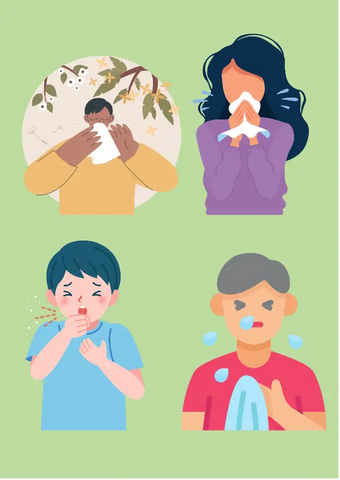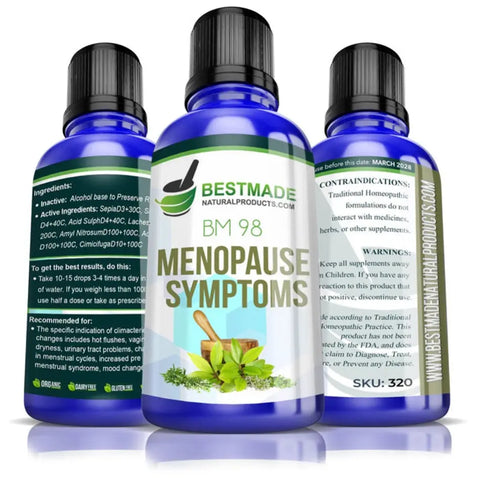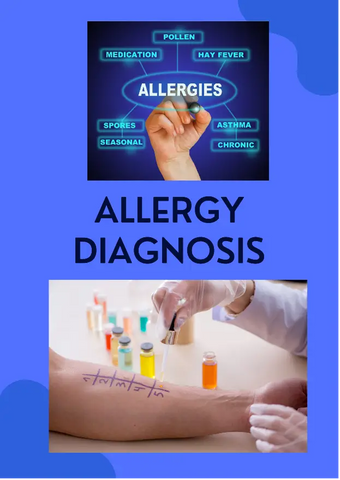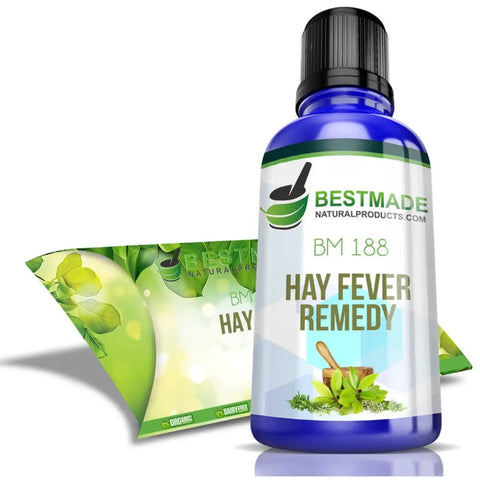
Learn How to Overcome Seasonal Allergies
BM188 is best used for hay fever, itchy and watery eyes, frequent sneezing, coughing, runny nose, post nasal drip and a scratchy, dry sensation in the throat.
Finally, spring is here!
You might have heard many people say this more than once. Spring is a beautiful city. The days are longer. The weather is nicer. Nature is even more beautiful. Yet, if you are unlucky enough to be amongst millions of Americans, with this beautiful season comes sneezing, coughing, and a runny nose.
This "unluck " is also known as seasonal or spring allergy.
What is an allergy?
An allergy is an unusual and excessive immune system reaction to various environmental substances or food ingredients, also known as allergens. When in contact with an allergen, the immune system releases histamine and leukotrienes, leading to specific reactions.
Allergy symptoms include:
- a runny nose
- coughing
- sneezing
- sore and itchy throat
- watery eyes
- itchy sinuses
- wheezing
- ear congestion
- skin rash
- headache
- shortness of breath

The tendency to develop allergies is genetic. So, if you’re wondering why you have to go through this every year, it might come from one or both of your parents.
The most common allergens are pollen, mold, mites, dust, pet dander, food, and insect stings.
Seasonal allergies: Explained
Let's talk more about seasonal allergens. Trees begin to bloom with the wake of nature in the early spring. Since their pollen is lighter than flower pollen, bees and other insects choose to collect pollen from the flowers. That way, much light pollen is left to travel in the air, especially on light-breezy days when the wind carries that pollen for miles.
Depending on the triggers causing your allergy, you might experience the symptoms in more than one season. If one of the allergens is present somewhere indoors, you might even suffer all year round.
Up to 30% of the world population is estimated to suffer from seasonal allergies, and half are ragweed allergies. Ragweed pollen is very lightweight, and it spreads quickly.
Spring allergies start in February and last until the early summer. Some variations are possible depending on the climate. The first to release pollen are the following trees:
- Cedar
- Alder
- Maple tree
- Pine
- Mulberry
- Birch
- Willow tree
- Ash
- Oak
- Beech
- Olive
- Cypres
- Cottonwood
- Elm

Sometimes around May, the grass starts releasing pollen. Weeds and grass that might trigger allergies are:
- Ryegrass
- Bermuda
- Timothy
- Saltgrass
- Fescue
- Orchard
- Johnson
- Zoysia
Being allergic to one pollen type does not mean you are allergic to all. Yet, most people have this common problem when ragweed releases its pollen in August. It is one of the prime allergens in North America. Ragweed can grow up to 6 feet tall. It has leaves made up of multiple leaflets roughly 6 inches long. The plant starts to bloom in late August, and the flowers appear like yellowish bumps. A single plant has both male and female flowers. After flowering, there are brownish fruits that are essentially dry single-seed fruits.

Mould
The amount of allergens in the air is lowest on rainy days. Yet, spring rains bring another common allergen, mold. It can be found outside and inside the house. Outside, you can find it in all dump places, like compost piles, fallen leaves, grasses, and rotting logs and trees. Mostly all decomposing plants can turn into mold nurseries. Inside the house, they are most noticeable in humid areas with reduced airflow, in damp rooms, like bathrooms, basements, and the kitchen. The mold allergy symptoms are an itchy nose, throat, and eyes, watery eyes, and runny nose.
Insects
With nature awakening, insects start their activity. Their bites and stings are another typical spring allergy cause. Insects that are high on the list of causing problems are mosquitos, bees, bed bugs, and ticks. Their bites usually cause itching, redness, swelling, and pain around the affected area. But they can also lead to a life-threatening allergic reaction. Anaphylaxis's common symptoms include pale skin, hives, trouble breathing, low blood pressure, choking, dizziness, rapid pulse rate, nausea, fainting, etc. If you notice any of these symptoms, seek immediate medical attention.
BM97 may help your body to deal with allergies, a runny nose, hay fever, skin conditions, raised eosinophils, wheezing, coughing, shortness of breath, and chest tightness.
In the summer months, most grasses release pollen. The allergy symptoms get worse during June and July. However, grass pollination lasts longer, so the symptoms may be experienced longer too. The main difference with symptoms is watery, itchy eyes, which appear in most cases for grass-allergy patients.
By mid-July, molds begin to blossom. They can be found outdoors and indoors, and the most common are Alternaria and Cladosporium. Molds reproduce with spores. Spores are the ones that cause allergic reactions, like red, watery eyes, runny nose, coughing, skin irritation, etc.
Fall is ragweed season. It is a very invasive plant and difficult to control. Ragweed can be found worldwide, and more than 40 species are known. Ragweed allergy symptoms can be pretty severe. People who suffer from ragweed allergy should avoid food like cucumbers, zucchini, chamomile, bananas, etc., since these plants contain pollen similar to ragweed.
In the winter, most allergens are indoors (dust mites, mold, or pet dander), meaning they are easier to control. You can take specific steps to keep them under control - we will discuss them later in the article.
Allergy diagnosis and treatment
When you suspect you may suffer from seasonal allergies, talk to your primary care doctor first. They may refer you to some specialists, like an otolaryngologist, pulmonologist, and allergist. The allergy specialist may order blood tests for total and specific IgE in the serum and a skin test. The skin test involves pricking the skin with a small amount of allergen under the skin's surface. If you test positive for some allergens, a red bump will form.

After diagnosis, allergy treatments recommended by doctors may include:
- Antihistamines - available by prescription or as over-the-counter drugs. They block a chemical called histamine that is responsible for allergic reactions. Antihistamines come in many forms, like pills, oral liquids, nasal sprays, and eye drops. Diphenhydramine and Chlorpheniramine may cause sleepiness, so try to avoid the oral use of these drugs.
- Decongestants - used for quick and temporary decongestion relief. They also come in pills, liquids, nasal drops, and nasal sprays. Side effects of using these drugs include high blood pressure, headache, and sleeping problems. Repeated use of nasal sprays may lead to a period when the congestion worsens.
- Corticosteroids- suppress allergy-related inflammation. Nasal sprays relieve runny nose and sneezing; eye drops relieve watery, red eyes. Inhalers are used as part of asthma caused by allergens treatment. Oral corticosteroids treat severe allergic reactions, and long-term use is not recommended since they may cause serious side effects.
- Other possible treatments include leukotriene inhibitors, biological medications, immunotherapy, mast cell stabilizers, and emergency epinephrine shots.
Talk to your healthcare about the treatment that is the best for you. When you already know what you are allergic to, the ideal is to start treatment about two weeks before your symptoms usually occur.
BM26 is best used for allergic bronchitis, chest tightness, wheezing, bluish skin, exhaustion, grunting respiration and restlessness.
Natural Remedies and Ways to Manage Seasonal Allergies
1. Avoid Allergens
The number one thing you can do is to avoid triggers. We know that is sometimes easier said than done. Here are a few steps that might help you keep your allergy symptoms under control.
- Check your local radio or online for pollen forecast and pollen levels
- Avoid going outside on warm and windy days
- Close your doors and windows when pollen counts are high
- Take off the clothes you were wearing outside and wash them as soon as possible
- Don't air dry the laundry
- Avoid gardening that might stir up allergens
- Try to avoid going outside in the early morning
- Shower to wash away pollen on your skin and hair when you come inside.
- Consider wearing a mask on windy days
- Use an air purifier in the house
- Change filters in your air conditioner regularly
- Use vacuum cleaners with HEPA filters
- Wash your pets after their walk since pollen could stay on their coat
- Do not forget to rinse your glasses if you wear them
2. Change your diet
Some vegetables may cause the same allergic reactions as tree or grass pollen, so it is best to avoid them. Foods botanically related to grass are tomato, orange, peach, celery, white potato, melons, pears, etc. If you are allergic to tree pollen, you should avoid cherries, kiwi, parsley, carrots, plums, almond, apples, etc. People allergic to weed pollen should avoid chamomile, cucumbers, bananas, artichoke, zucchini, hibiscus, etc.

Eat organic food grown without pesticides and herbicides. Here is a list of foods you can add or subtract from your diet that might help you ease your symptoms:
- Green tea - contains natural antihistamines. One cup in the morning might ease allergy symptoms.
- Yoghurt and probiotics are friendly bacteria that help regulate your immune system. Yoghurt is a natural source of probiotics.
- Omega 3 - adding fatty fish to your diet will boost your immune system since they are rich in omega-3 fatty acids.
- Try the Mediterranean diet, a well-known diet worldwide with many proven health benefits, like lower blood pressure, better heart health, lesser asthma attacks, etc. The diet includes meals made of fresh fruit, vegetables, fish, and nuts.
- Limit salt intake
- Avoid fast food
- Avoid spices- they might raise histamine levels in your body and worsen allergy symptoms.
- Avoid gluten, dairy, and sugar
- Avoid raw food during the high pollen season
A healthy diet supports your overall health. Before you make any changes to your diet, talk to your doctor. If you avoid certain foods, make sure you replace the needed nutrients.
3. Remember your vitamins.
Vitamin D is known as the sun's vitamin but can also be found in milk, eggs, fish, grains, and mushrooms. Many studies show that vitamin D contributes to the normal function of the immune system. Vitamin D supplementation in pregnant women lowers the number of asthma and allergy-related problems in young children. Since it is possible to overdose on vitamin D, it is essential to do a blood test to check your vitamin D levels. Normal vitamin D levels in the blood of an adult person should be 20 ng/ml or higher. Vitamin D overdose side effects include vomiting, nausea, confusion, abdominal pain, increased urine output, etc.
Vitamin C is a natural antioxidant and antihistamine. Its antihistamine properties help reduce asthma and allergic rhinitis symptoms and protect lung function. Vitamin C is not stored in the body, so the risk of overdose is minimal. The recommended daily intake for allergic rhinitis is 2000mg. An excessive amount of vitamin C may cause gastrointestinal problems since the GI tract limits the amount of vitamin C absorption. Foods you can find with vitamin C are plums, acerola, kale, spinach, rose hip, broccoli, brussels sprouts, citruses, etc. People with medical conditions like iron deficiency, cancer, and kidney stones, should discuss vitamin C supplementation with the doctor.

Quercetin is a bioflavonoid found in asparagus, onions, tea, apples, broccoli, tomatoes, kale, berries, and red wine. Quercetin stabilizes cells that release histamine, which reduces allergy symptoms. It may also help with high blood pressure, diabetes, prostate problems, high cholesterol, etc. Avoid using quercetin if you are pregnant, breastfeeding, or have kidney problems. The maximum daily intake is 800mg, divided into two doses. It is recommended to start the use before the pollen season to avoid the symptoms from the onset.
Butterbur is a shrub that grows in some parts of North America, Europe and Asia. It is known for its antihistamine properties and may help with itchy eyes.
Other supplements you may try are algae spirulina, bromelain, stinging nettle, tropical fruits, extracts, etc.
Before adding any vitamins and supplements to your diet, discuss other health problems and possible side effects of the supplements with your doctor.
4. Lifestyle changes
If you exercise, do not stop if you have seasonal allergies. You must adjust your time outside according to pollen and mold counts. You can find them locally, online, or in the newspapers, after the pollen season starts.
Try nasal irrigation. You flush out allergens and mucus from your nose by rinsing your nasal passages with saline solutions. You can buy them as a ready-to-use kit. If you prepare solutions at home, boil the water before use to avoid infections. Always wash the irrigator device after use and dry it.

You can try acupuncture and mindful treatments, yoga, meditation, etc. All of these treatments have proven health benefits. Ensure you start with a qualified instructor to avoid health problems.
Give Homeopathy a try, as it moderates the overactive immune system. Homeopathic remedies treat the individual symptoms of every patient. They can be used to treat allergic rhinitis (Allium cepa, Arsenic album, Kali bichromicum, etc.), cough (Ipecac, Arsenic album, Sambucus, etc.), and skin rashes (Apis mellifica, Sulfur, Urtica urens). Talk to your homeopathic specialist about the remedy combination that best treats your symptoms.
The Bottom Line
Seasonal allergies can make you very miserable. Yet, there is a lot you can do to ease the symptoms. Avoidance is number one. By keeping the allergens away, you do half the work. By adding treatments, herbal remedies, and lifestyle changes, you could almost be symptoms free; and start to enjoy all the excellent stuff Spring and outdoor activities offer.
BM39 is best used for mastocytosis (numerous, itchy, irregular, yellow or orange-brown swelling on the skin); allergy from food (milk, eggs, shellfish or nuts); and medicine allergy.
Sources: Healthline, Mayo Clinic, Zyrtec, ACAAI, Cleveland Clinic, Bestmade Natural Products







Leave a comment